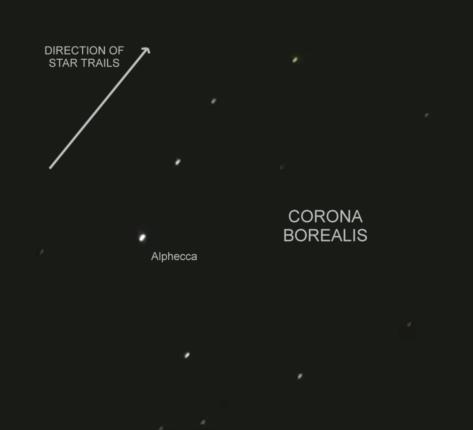
NavList:
A Community Devoted to the Preservation and Practice of Celestial Navigation and Other Methods of Traditional Wayfinding
From: Frank Reed
Date: 2024 Jan 16, 11:19 -0800
A few days ago I asked if anyone could identify the stars in that brief scene in "Oppenheimer". Rob van Gent and Jeremy H both spotted it quickly.
Rob van Gent, you wrote:
"The fact that the brightest object is distinctly yellowish makes the surrounding star field rather easy to identify – rotate the image counter-clockwise and it should be obvious that Oppenheimer was looking at several well-known stars best viewed during the spring and summer nights.
The two brightest objects are also navigational stars."
Yes, indeed. Arcturus and Alphecca --two of the official navigational stars. Nice!
Jeremy H, you also spotted it and asked in a follow-up:
"and was he looking straight up?"
Almost straight up, perhaps. Whoever created the image or took the photo was probably pointing at a high angular altitude. The central declination in the image appears to be around 16°N so an observer in the same latitude, 16°N, would see that point at the zenith at some point during the night. Of course the image could also represent the appearance of the stars when near the horizon, but given some assumptions about the season of the year, near the zenith makes sense.
I took a closer look at the stars in this image, and I now think it may well be an actual photo, perhaps captured by the writer/director/auteur of "Oppenheimer", Christopher Nolan. He seems like the kind of creator who might have visited the country around Los Alamos to get inside his character. And I can imagine him placing his phone on a nearly level surface and setting it to capture this photo. The limiting magnitude of stars in the photo is around 6.5, which is not hard to achieve with modern smartphone cameras, and this brightness limit reasonably reflects the sky that Oppie and friends would have seen under very dark skies in 1942. The timing may be wrong, but that would be nitpicking.
There's real evidence that it's a photo and not cgi. The stars are trailed [see image below]. When I zoomed in, I could see short trails that are about what would be expected from a 30-second exposure time. I didn't check to see if these trails change during the short time the stars are on-screen in the film. It could just be an artifact. Arguing in favor of actual exposure trailing, the star trails are properly aligned with lines of declination, which is the direction of the normal daily motion of the stars. So that's consistent. :)
Frank Reed







